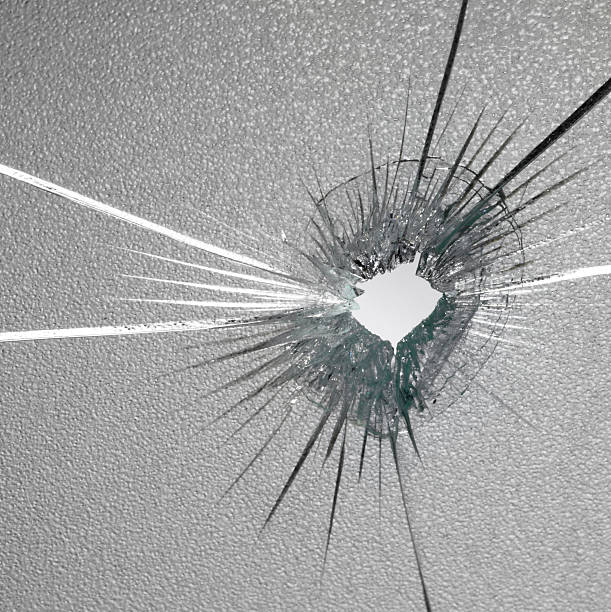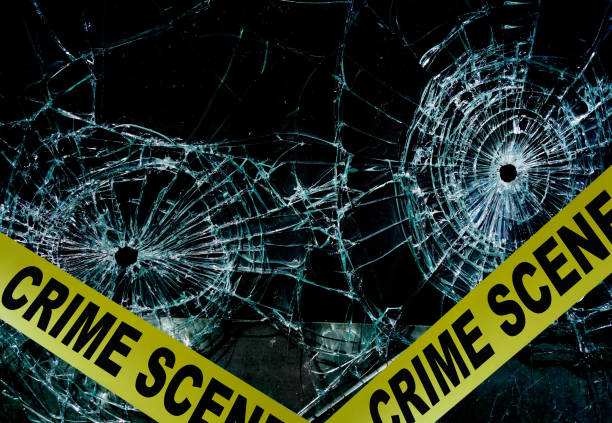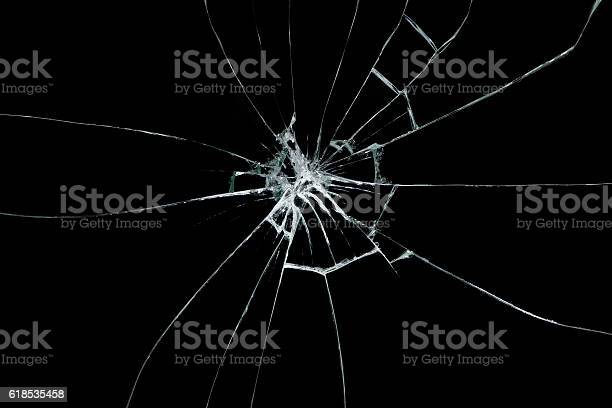Glass fracture is the breakage of glass due to the tensile strength that pulls the surface of the glass apart and hence exceeds the elastic limit. The strength of the glass is in its surface. Glass has less tensile strength than compressive strength. When a force pushes on one side of glass, the elasticity of glass permits it to bend in the direction of force applied. Once the elastic limit exceeds the glass begins to break.
The glass fractures frequently encountered in various crimes like burglary, road accidents , hit and run cases etc.
The glass fracture often reveals information about the force, direction and angle of an impact. Such knowledge may help the investigator in reconstruction of crime scene.
TYPES OF GLASS FRACTURE
At the crime scene various glass fragments are found that determines the glass fracture patterns.
- RADIAL FRACTURE: the penetration of ordinary window glass by a projectile, whether it is bullet or stone, produce a fracture pattern which radiates outwards like a spoke of wheel from the point at which glass was stuck. This radial glass fracture produced at the opposite to the one where the force had been applied. This fracture always appears first on glass.
2. CONCENTRIC FRACTURE: the concentric glass fractures are the secondary fracture and occur after radial fracture. If the force continues even after the radial fracture, the tensile stress develops on the side where the force was applied. This leads to series of concentric circles around the point of contact known as concentric fracture. This fracture or cracks are applied on the same side where the force was applied. This fracture connect with the adjacent radial fracture.
3. CONE FRACTURE: this type of crack or fracture is formed when a high velocity projectile object such as bullet penetrates the glass which exceeds its elasticity limit. It often leaves a round crater shaped hole surrounded by radial and concentric fractures. This hole actually determines the side of impact as it is wider on the exit side. However, as the velocity of penetrating projectile decreases, the irregularities of shape of hole, and its surrounding cracks increases so at that point the hole shape may not determine the direction of impact. At this point, the radial and concentric fracture determines the direction of impact.

The direction of cone depends upon the speed on the propagation of projectile:
- If a projectile propagates inn perpendicular manner, the hole is symmetrical.
- In case of high velocity projectile such as rifle bullet, will yield a small hole with minimum flaking around circumference. A slow moving bullet delivers more irregular hole with more flaking.
- If an intermediate target has reduced the velocity of projectile in considerable manner , the glass may show evidence of tension propagated fracture with no crater/hole formation.
4. RIB FRACTURE/ STRESS LINE: the edges of broken piece of glass bears a number of curved lines termed as stress lines. These stress lines are tangent to the one side of the glass and perpendicular to other side. They are always perpendicular to the surface at which the crack is originated. In radial fracture, the rib marks are perpendicular to the side opposite to which the force has been applied and in concentric fracture, the ribs marks are perpendicular to the side of the applied force.
A convenient rule for remembering these observations is the 3R rule– Radial cracks forms Right angle on the Reverse side of the force.
5. HECKLE MARKS: these are small irregular lines that are appeared on the edges of the broken glass. They appear perpendicular to rib marks.
6. THERMAL FRACTURE: these are irregular wavy shaped fracture formed due to excessive exposure to heat. If a very hot liquid is poured in cold glass or very cold liquid pour in hot glass, a thermal shock produced leading to this type of fractures.
BACKWARD FRAGMENTATION OF GLASS
When a sheet of glass is broken, most of the glass fragments travel in the direction of force but few small glass fragments or chips are also thrown backwards. The projection of glass particles towards the person or object breaking a window known as BACKWARD FRAGMENTATION. This is actual mean by which someone who is breaking a window acquires glass particles on his or her clothing.
ANGLE OF IMPACT ON THE GLASS
The angle at which projectile strikes the glass determine the amount of chipping on the exit side.
- If a bullet strikes the glass at right angle to the surface, there will be equally distribution of glass chipping on the opposite side and leaving a symmetrical hole.
- If a bullet strikes the glass from the left side of the surface, there will be chipping around the right side of the exit surface and forming an elliptical hole.
- If a bullet strikes the glass from right side of the surface, everything will be reversed.
DIRECTION OF IMPACT
The direction of impact of glass can be determined by the direction of radial, concentric and cone fractures.
- The radial glass fracture produced to the opposite side from where force applied.
- The concentric glass fracture produced to the same side from where the force applied.
- In cone fracture, the hole is usually wider at the exit side as compared to the entry side and gives the appearance of the cone.
SEQUENCE OF HOLES IN GLASS FRACTURE
Where there are two or more the two holes in the glass plane, it may be possible to determine which hole was made first. A radial glass fracture in glass travels some distance depending upon the force of impact, but if it meets another fracture that has been formed earlier, it will terminate at that point. Consequently, if fractures from one bullet hole are stopped by those made by second bullet hole, it may be assumed that the hole that was made by second bullet was made earlier. Infig2, the fractures made by A bullet was made earlier and fracture made by bullet B was formed later.
VELOCITY AND DISTANCE OF FIRING
It may be possible to determine the velocity of the projectile from the nature of the hole. A high velocity bullet will make an almost circular hole in a glass pane without much cracking. A projectile fired from a long distance will have most of its velocity spend before it reaches the pane of glass, and it will break the pane in much the same way as in the case of stone. A bullet fired from close range will shatter the glass due to the muzzle blast and leaves powder residue on the surface.
subscribe to our blog for more updates.








